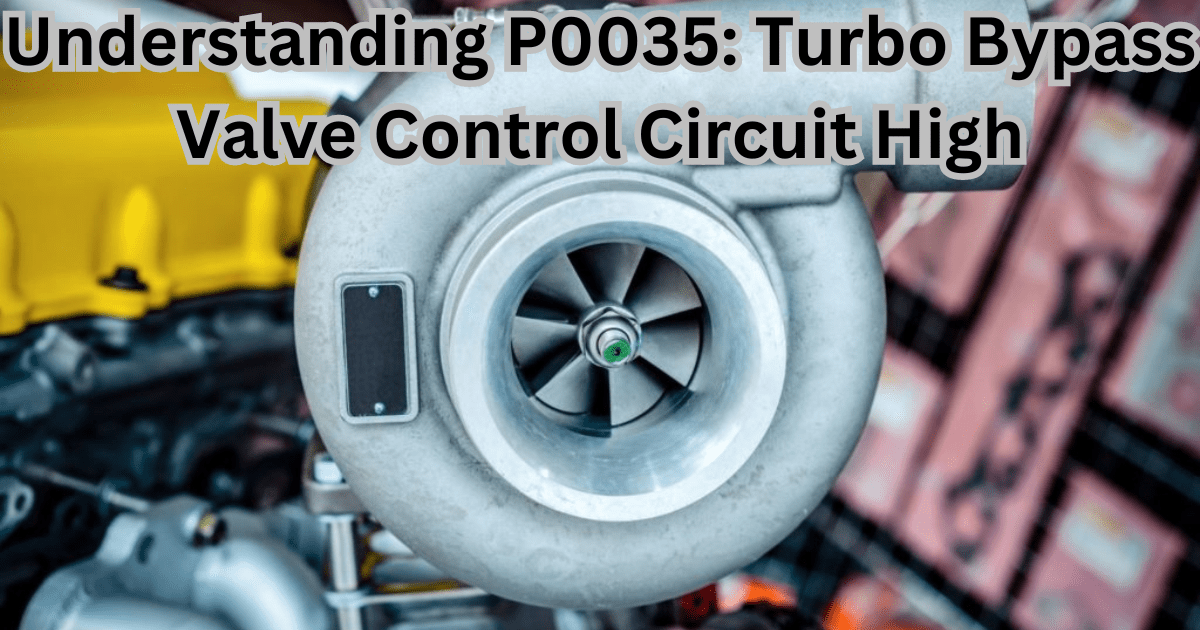This OBD-II number, P0035, is for all vehicles with a turbocharged engine that were made after 1996. This is what the code means: P0035 Turbocharger / Supercharger Bypass Valve Control Circuit High
What It Means and How to Fix It
You might see the diagnostic trouble code (DTC) P0035 if your car has a turbocharged engine. This code means there is a problem with the circuit that manages the turbocharger bypass valve. This valve controls the flow of air into the engine. This post will talk about what this code means, how to fix it, and what causes it.

The turbocharger bypass valve can be used to change the boost pressure, which is the pressure of the air coming into the engine. The turbocharger spins faster and makes more boost pressure when the engine needs more power. The turbocharger spins less quickly and makes less boost pressure when the engine needs less power. The turbocharger bypass valve helps keep the boost pressure at the right level for each engine situation.
An electric actuator and a monitor work together to control the turbocharger bypass valve. The actuator moves the valve when the powertrain control module (PCM) tells it to. It sends information to the PCM about where the valve is located. The PCM checks a number of engine sensors to figure out where the valve should be and tell it to move to that place.
As soon as the PCM finds a high voltage signal in the circuit that handles the turbocharger bypass valve, it sets P0035. A short to power, low resistance, or high voltage could be what this means.
What are Some Other Codes Related to P0035?
- P0033 Turbocharger / Supercharger Bypass Valve Control Circuit
- P0034 Turbocharger / Supercharger Bypass Valve Control Circuit Low
- P0234 Turbocharger Boost Sensor A Circuit Low
- P0235 Turbocharger Boost Sensor A Circuit High
- P0294 Turbocharger Underboost Condition
- P0299 Turbocharger Overboost Condition

What are Some Possible Causes of P0035?
- Turbocharger bypass valve that doesn’t work right: The valve might be stuck, broken, or leaky, which stops it from moving or sealing properly.
- Faulty turbocharger bypass valve actuator: The actuator may be broken, so it won’t move or listen to commands from the PCM.
- A problem exists with the wiring or connection for the turbocharger bypass valve actuator. The wiring or connector could be broken, corroded, or loose, which would stop the circuit from communicating or supplying voltage.
- Problem with the PCM: The PCM might not be working right, which means it sends the actuator the wrong signal or no signal at all.
What are Some Common Symptoms of P0035?
The signs of P0035 can be different based on how bad the problem is and what caused it. These are some of the most common signs:
- Check engine light on: When the PCM sets the code, the check engine light will come on.
- Less power and economy from the engine: If the bypass valve isn’t working right, it could change the engine’s boost pressure and air-fuel ratio. This could mean less speed, slower acceleration, and worse gas mileage.
- Too much or too little boost pressure: If the bypass valve isn’t working right, the engine may have too much or too little boost pressure. This could hurt the engine parts or make the engine work less well.
- Stopping: If the bypass valve isn’t working right, it could let too much or too little air into the engine, which could make the idle unsteady or cause the engine to stop.
- Sounds like squealing or clanking coming from the turbocharger or turbo pipes: If the bypass valve is stuck, broken, or leaking, it could cause strange sounds to come from the turbocharger or turbo pipes because of too much or too little boost pressure.
- Heavy smoke coming out of the tailpipe: If the bypass valve isn’t working right, it could let too much or too little fuel into the engine, which would lead to incomplete burning and more pollution. This could cause a lot of smoke, mostly black smoke, to come out of the tailpipe.
It’s also possible to keep other codes, such as codes related to the turbocharger boost, engine misfire, or knock sensor. These codes show more detailed issues with the turbocharger system, the way the engine works, or the detonation of the engine.
If it applies, the boost pressure gauge may also show that the boost pressure is too high. It’s possible that this means the bypass valve isn’t controlling the boost pressure properly.
How to Fix P0035?
You will need a scan tool, a digital multimeter, and a repair manual for your make and type of car in order to fix P0035. These steps will help you figure out what’s wrong and fix this code. For more detailed directions and specs, you should always look at your repair manual.
- Look for codes in your car. You can get any stored codes and freeze frame info from your car’s PCM by using a scan tool. You should write down any codes and what they mean, as well as any useful data from the freeze frame, like the engine’s speed, load, temperature, and so on. Get rid of the codes and test drive your car to see if they come back.
- Check the engine bypass valve and all of its parts. Check the bypass valve, its actuator, its sensor, and its wires and connectors for damage, wear, corrosion, or connections that aren’t tight. Check to see if the bypass valve or its hoses are leaking. As needed, replace any parts that are broken.
- Check the actuator for the turbocharger’s bypass valve. Take off the wire that connects to it and use a digital multimeter to see if there is resistance between its ends. Check what you read against what it says in your service manual. Change the actuator if it’s not in the right range.
- Check the sensor for the turbocharger bypass valve. Take off the plug and use a digital voltmeter to check the terminals for voltage and ground while the key is on and the engine is off (KOEO). Check your readings against the instructions in your repair guidebook. It you find that they are not in range, check the wiring and connections of the sensor circuit for continuity and resistance. If any of the lines are open or short, fix them. If they are in range, connect the sensor again and use a digital multimeter to check the signal wire on the back of it while running the actuator by hand or with a scan tool command (if available). Check to see if the signal value changes based on where the bypass valve is placed. Check what you read against what it says in your service manual. If it’s not in range or doesn’t change, the sensor needs to be changed.
- The wiring and connections in the circuit that controls the bypass valve should be checked. Find the circuit’s power, ground, and signal lines with the help of a wiring diagram. When you look at the circuit with a digital voltmeter, you can find voltage drop, continuity, resistance, and shorts. As needed, fix any wires or connections that are broken.
- Look for other codes that go with mine. If there are other codes saved with P0035, you should find and fix them first before you clear the codes and test the car.
Conclusion
The code P0035 means that there is a problem with the circuit that handles the turbocharger bypass valve. This code can make your car’s efficiency and emissions worse in a number of ways. It is recommended that you have a professional repair look at your car if you notice any of the above signs.




